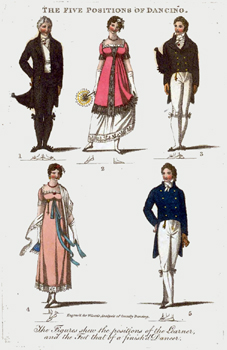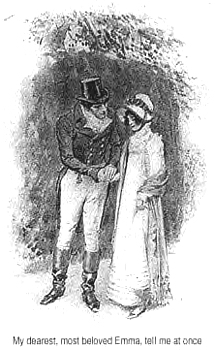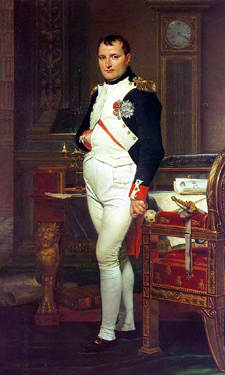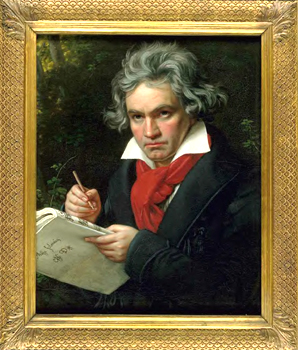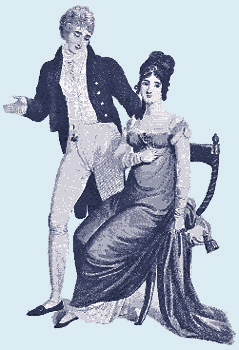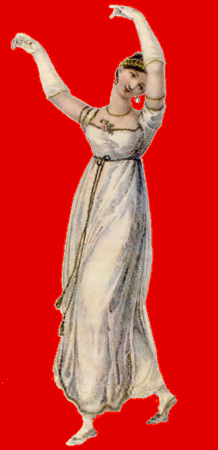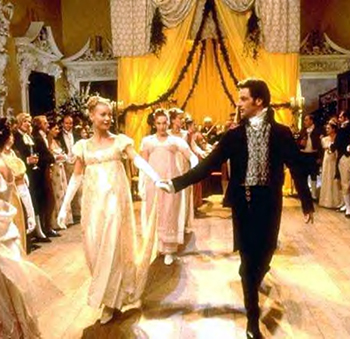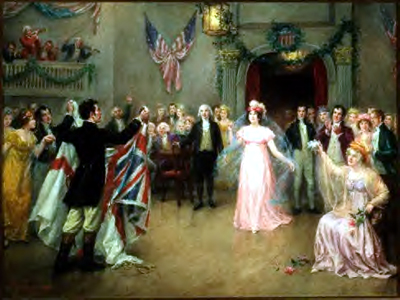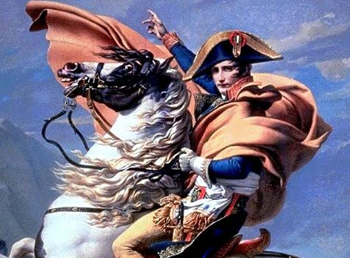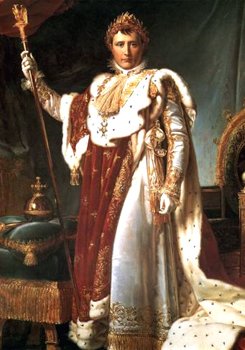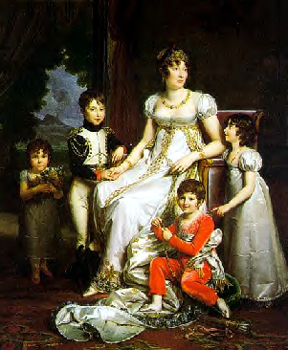
Women’s clothing of the Regency era reached heights of classic simplicity that had not been seen
for centuries. Caught up in at least a fashion oriented sense of “liberté,
equalité, fraternité,”
clothing designers, artists and architects began to look back to the
democracies of ancient Greece and the Roman Republic for inspiration. Ladies
abandoned the panniers, horizontally emphasized dresses and heavy fabrics of
18th century fashions in favor of vertical, draping, more natural styles which were
light in both color and weight. Gone were heavy, rich brocades in favor of a
simple white cotton muslin similar to our modern batiste. Ornamentation, while
still existing, tended to be understated in comparison to the previous era
when opulence and overindulgence were often the norm among the wealthy
classes. Simplicity and understatement came to be viewed as beautiful,
tasteful and elegant.
Men’s fashion changed too. Thomas Jefferson set a trend, when at his
inauguration as our third president in 1801, he broke with past fashion by
wearing lace-up shoes rather than shoes with buckles. He did this to make a
statement regarding his sympathy for French Republican ideals. Though all
classes had worn shoe buckles, in France they had come to be viewed as a
symbol of aristocracy, perhaps because of the old boast that some rich men
wore buckles so jewel-encrusted that they had “the value of a good farm on
each foot”. In France breeches also came to be seen as “aristocratic” (again,
even though all classes had worn them) and revolutionaries took to wearing the
new tight-fitting, pantaloons and longer, somewhat looser trousers. Thus the
revolutionaries came to be referred to as “sans culottes”, basically
translated as “those without breeches”. To be seen wearing breeches and shoes
with fancy buckles during the “Reign of Terror” in revolutionary France was to
risk a rendezvous with Madame Guillotine. All this aside, though it would be
fair to say that France produced the ladies' styles of the time and certainly
affected men's styles as well, yet England had the predominant influence on
men's fashions. A well dressed gentleman of the Regency era in tailcoat and
boots was after all in essence imitating the equestrian attire of English
country gentlemen. But back to the ladies...
The ladies dress of the time was a long, draping, usually light colored,
always lightweight gown. It would have the classic, high “empire” waist
immediately beneath the bosom and would probably be made from
cotton or silk fabric in a solid, a small printed pattern or vertical stripes.
White was the favorite color of ladies during the Regency era though just
about any light color was used. At different points during the period either
short or long sleeves were in style. Sometimes light, transparent
“overdresses” were worn and the “Spencer Jacket” came into vogue as a
fashionable means of acquiring a bit of protection from cold temperatures
uninhibited by mere thin
gowns. Underneath would have been the Regency era corset. This corset was
designed to force an erect posture and to hold high the bosom in a manner
termed “lift and separate.” It was worn over a long linen or cotton chemise.
The “poke bonnet” was ubiquitous and for a time turbans and long plumes were
quite the fad for headwear. Diadems (another adaptation from classical Greece)
were popular for evening wear.
For middle or upper class men the tailcoat of the period was a must. Even the
lower classes often wore it. This tailcoat came up quite high behind the neck
and hung down in a long, split tail which was at first horizontal across the
bottom but in time the "clawhammer" variety appeared as well.
Early in the period the front rounded up in an arch but later it
was a bit lower and cut straight across. Either way it was designed so that
the waistcoat would show a little underneath. The tailcoat could be worn in
many colors for daywear but darker shades such as black and navy were best for
evenings. The coat would be worn over a high, standing-collared vest (either
single or double breasted) which in turn would be worn over a high-collared
white shirt of linen or cotton. “Drop-front” trousers and pantaloons were the
new fashion but for quite some time drop-front breeches coming to just below
the knees remained the preferred article for evening wear. (Except perhaps in
revolutionary France during the 1790s!) It was during this era that the top hat first made its appearance. The Regency version was
quite tall and straight with a narrow turned-up brim. The wide bicorn was also
popular, though unlike the top hat its general use faded quickly with
the end of the Regency era. A long linen or silk cravate which wrapped around
the neck was a necessity for a gentleman and could be tied in a variety of
styles.
Men wore knee high boots (similar to English riding boots), "Wellington Boots"
or a “Jefferson” style, ankle height, lace-up “bootee.” Low-cut men's slippers
were common as well. Ladies often wore a
shoe similar to a low-heeled modern ballet slipper or a style with a bit more
heel which
might perhaps be an ancestor of today’s pumps.
Many well known movies (most based on classic novels) have portrayed different
aspects of the Regency era. Among them are Pride & Prejudice, Emma, Mansfield
Park, Sense & Sensibility, The Scarlet Pimpernel, A Tale of Two Cities, Les Miserables, War and Peace, the Hornblower series, and Waterloo. There have
also been documentaries produced regarding such persons as Napoleon I and
Thomas Jefferson and events such as The Lewis & Clark Expedition, The War of
1812 and The Battle of New Orleans.
© 2001-2006 Please note: This article and webpage are the copyrighted
property of the author and may not be copied or otherwise reproduced in whole or in part without
express written
consent.

We Make History
Presents
A Regency Era Primer
Circa 1795-1825
by Lord Scott
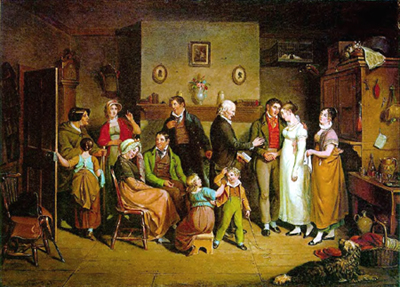
REGENCY LINKS
Ladies' Fashions of the Regency Era
Gentlemen's Fashions of the Regency Era
